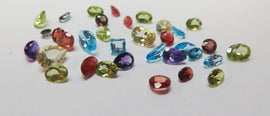Every diamond is unique and one of a kind. Understanding the differences and how they impact the value of the stone will help you decide in selecting a diamond.
The 4C’s of Diamond quality (Color, Clarity, Cut and Carat Weight) have been the globally accepted standard for describing the quality of diamonds since 1939. These characteristics provide the framework for understanding the basic information about the stones; however there are other criteria – like cut grade, fluorescence, and culet size, that can also impact the value of a diamond. As a result, two diamonds with the same 4C’s criteria may be very different in value.
We are happy to explain these characteristics in detail, and we’ll show you multiple choices in your price range, and help you select the perfect diamond.
COLOR
 Diamond color grading is based on the absence of color, and is an important element of each stone’s unique beauty. The industry standard scale for color was developed in the 1950’s by the Gemological Institute of America. GIA’s diamond D-to-Z color-grading scale begins with the letter D, representing colorless, and continues, with increasing presence of color, to the letter Z.
Diamond color grading is based on the absence of color, and is an important element of each stone’s unique beauty. The industry standard scale for color was developed in the 1950’s by the Gemological Institute of America. GIA’s diamond D-to-Z color-grading scale begins with the letter D, representing colorless, and continues, with increasing presence of color, to the letter Z.
The “D to Z scale” doesn’t describe actual colors, but a range of color that is based on a diamond’s tone and saturation. A colorless diamond is void of any color tone. D, E and F are considered “colorless grades”, with D being the highest color grade a diamond can receive. Many of these color distinctions are so subtle that they are invisible to the untrained eye; however, these distinctions make a very big difference in diamond quality and price.
G, H, I and J are described as “near colorless”. These four grades are what you will typically see available in most retail jewelry. K, L, and M are listed as “faint”. As the letters progress closer to Z, the diamonds will show more yellow, brown, and grey tones.
Diamonds that fall outside of The D to Z Scale are then considered fancy color diamonds. Probably the most popular and common of the fancy colors is brown, followed by yellow. However, diamonds also come in pink, blue, red, green, purple and orange, though they are very rare in natural diamonds. A perfect example of this is probably the most famous blue diamond, The Hope Diamond.
Special Colored Diamonds
All fancy colors are available at Jonathan’s Jewelers, and we stock a variety of fancy yellow, orange, and pink diamonds. In addition, we have partnered with trusted vendors to bring our customers some of the world’s most rare and fancy colored diamonds – these highly coveted fancy red, green, blue and pink diamonds are a spectacular addition to any collection.
CUT
 Diamonds come in many shapes; and often this is the first thing to decide when looking at diamonds. However, rating or grading the cut of a diamond is really about how well a diamond’s facets interact with light – in any shape, how well it is cut is what gives a diamond its brilliance and refractive qualities.
Diamonds come in many shapes; and often this is the first thing to decide when looking at diamonds. However, rating or grading the cut of a diamond is really about how well a diamond’s facets interact with light – in any shape, how well it is cut is what gives a diamond its brilliance and refractive qualities.
The most popular cut shape is the modern round brilliant cut. It offers the greatest display of light performance and is considered the classic diamond shape. Because of its popularity and ability to present the best a diamond has to offer, more diamonds are cut in this shape than any other.
Shapes other than round are called fancy cuts. In 2018 asscher, oval, and cushion cuts are the most popular fancy cuts. Other popular cuts are marquise, pear, emerald, heart shape, and princess cut.
The Gemological Institute of America has recently recognized what is considered an ‘Ideal Cut’ when in reference to round diamonds. This grading system has specific parameters in regards to proportion. However, in over 35 years of viewing and classifying diamonds, we’ve witnessed Mine cut, European cut, Transitional cut and Modern Brilliant cuts of extraordinary beauty, and these don’t fall into the category of Ideal Cut by GIA or AGS standards.
Cut is graded by a simple scale: Excellent, Very Good, Good, Fair and Poor. However, there are many combinations of table, depth, girdle thickness, and culet size this can influence the brilliance of a diamond that can produce a beautiful stone.
CLARITY
 Diamond Clarity describes inclusions and blemishes that a diamond might have. Internal characteristics are called ‘inclusions’, and external characteristics are called ‘blemishes’. Diamonds are like fingerprints – no two diamonds will have the exact same clarity characteristics. A common edge blemish is a trigon, a natural skin blemish left on the girdle.
Diamond Clarity describes inclusions and blemishes that a diamond might have. Internal characteristics are called ‘inclusions’, and external characteristics are called ‘blemishes’. Diamonds are like fingerprints – no two diamonds will have the exact same clarity characteristics. A common edge blemish is a trigon, a natural skin blemish left on the girdle.
It is important that you do not think of inclusions as “flaws” or “imperfections”, but rather as a birthmark. Inclusions are what makes each diamond unique and can even appear in interesting shapes such as hearts or snowflakes which may make it more appealing.
Evaluating diamond clarity involves determining the number, size, relief, nature, and position of these characteristics, as well as how these affect the overall appearance of the stone. While no diamond is perfectly pure, the the leaner it is, the higher its value.
The GIA Diamond Clarity Scale has 6 categories, some of which are divided, for a total of 11 specific grades:
- Flawless (FL) – No inclusions and no blemishes visible under 10x magnification
- Internally Flawless (IF) – No inclusions visible under 10x magnification
- Very, Very Slightly Included (VVS1 and VVS2) – Inclusions so slight they are difficult for a skilled grader to see under 10x magnification
- Very Slightly Included (VS1 and VS2) – Inclusions are observed with effort under 10x magnification, but can be characterized as minor
- Slightly Included (SI1 and SI2) – Inclusions are noticeable under 10x magnification
- Included (I1, I2, and I3) – Inclusions are obvious recognized with the naked eye which may affect transparency and brilliance
Many inclusions and blemishes are too tiny to be seen by anyone other than a trained diamond grader.
To the naked eye, FL to SI2 diamonds may look exactly the same, but these diamonds are quite different in terms of overall quality. This is why expert and accurate assessment of diamond clarity is extremely important.
When looking for inclusions, a jeweler will use a hand eye-piece called a loupe, which usually has a magnification of 10x. Flawless and internally flawless diamonds are very rare and are very seldom seen in a retail setting, but are available. On the other hand, while diamonds given an I clarity grade may not be idea for a focal stone in a ring, they can be useful in earrings, or a pendant as the angle of light entering the diamond would be not make the inclusions noticeable.
CARAT WEIGHT
 Carat weight refers to the weight, not the size, of a diamond.
Carat weight refers to the weight, not the size, of a diamond.
Carat weight is the metric term used to measure the weight of diamonds. The term ‘carat’ originated from the use of a carob seed when weighing diamonds – 5.00 carats is equal to 1 gram, and there are 100 points to one carat.
A one carat diamond has a millimeter size of 6.5 which is about equal to the diameter of a #2 common pencil eraser.
All else being equal, diamond price increases with diamond carat weight, because larger diamonds are more rare — and more desirable. But two diamonds of equal carat weight can have very different values depending on three other factors of the diamond 4Cs: Clarity, Color, and Cut. Additionally, two half-carat diamonds of G color and VS clarity will not be the same in value as a one-carat diamond of the same quality – as the value of any diamond increases with its size.
For more information, visit the GIA website.


